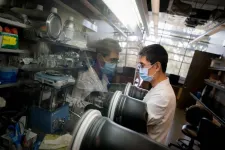(Press-News.org) A $162 million investment from the U.S. National Science Foundation will drive the creation of advanced materials capable of remarkable things — from being tough enough to withstand the heat of a fusion reactor to processing information at the quantum level. Nine Materials Research Science and Engineering Centers (MRSECs) will each receive $18 million over six years. The centers aim to transform fundamental scientific breakthroughs into tangible benefits for multiple sectors of the U.S. economy and innovations that can be produced on tomorrow's factory floors.
"NSF's Materials Research Science and Engineering Centers will help us seize new opportunities in semiconductors, biotech, quantum information and more, addressing the needs of our society and advancing critical emerging technologies," said NSF Director Sethuraman Panchanathan. "They will do so by expanding and enriching the ecosystem of innovation across our country."
From Tennessee to Washington state, the 2023 class of MRSECs are located at nine institutions across the country. In total, NSF now supports 20 such centers. The latest ones will expand the centers' portfolios to pursue a broad range of research projects to unlock new capabilities in a number of areas: semiconductors, artificial intelligence, biotechnology, sustainable energy sources and storage, advanced manufacturing, quantum computing and sensing, and other areas critical for U.S. leadership in materials research. In addition to enabling new commercial opportunities and industries in the U.S., the centers will train students and early career researchers who will become tomorrow's scientific and technical leaders.
"Since the 1970s, NSF's Materials Research Science and Engineering Centers have yielded countless breakthroughs, from shape-morphing materials to plastics that conduct electricity," said NSF Assistant Director for Mathematical and Physical Sciences Sean L. Jones. "Our current centers continue that proud tradition and provide the essential catalyst — born in the materials lab — which ignites American innovations that propel our country's scientific and economic leadership."
NSF's support for the centers also provides resources to train hundreds of undergraduate and graduate students, along with educational STEM programs that will engage hundreds more K-12 students and teachers in dozens of school districts. The centers will engage with local startups and the business community to form partnerships that can take novel materials from the discovery phase to commercialization. Dozens of collaborating institutions will also participate with the centers, including many minority-serving and emerging-research institutions.
The nine 2023 centers are:
Illinois Materials Research Science and Engineering Center
Located at the University of Illinois Urbana-Champaign, the center will investigate 1) how strain in materials can be used to control the motion of electrons and can enable novel information storage and processing models in quantum materials as well as for energy production and storage, and 2) materials with light-controlled conduction of ions with applications in new electrochemical manufacturing, energy and information technologies.
Center for Dynamics and Control of Materials
Located at The University of Texas at Austin, the center will design 1) new soft biomaterials whose structure and functionality can be actively controlled and which can be used for applications such as synthetic cells and adaptive thermal coatings, and 2) atomically thin materials with novel structures that can be useful for microelectronics, quantum information processing and other applications.
University of Washington Molecular Engineering Materials Center
Located at the University of Washington, the center will develop 1) materials in which light can tune the magnetic properties of individual electrons for applications in quantum information processing and sensing, and 2) so-called "elastic quantum matter" materials in which strain forces produce and influence quantum-scale effects.
Northwestern University Materials Research Science and Engineering Center
Located at Northwestern University, the center aims to create 1) bio-inspired materials that can be programmed to perform self-directed functions, like self-healing and shape-morphing, which could be used in food-storage, clothing or wound care, and 2) materials that conduct both electrons and ions, mimicking the capabilities of brain neurons.
Laboratory for Research on the Structure of Matter
Located at the University of Pennsylvania, the center will develop 1) new materials that can adapt to their surroundings and external triggers, with potential applications ranging from flexible materials that can deflect the energy of, for example, a hammer blow to creating soft robots that can perform complex tasks, and 2) tissue-like synthetic biomaterials made from cellular building blocks capable of the controlled release of key molecules inside cells, akin to drug delivery.
Materials Research Laboratory at UCSB
Located at the University of California, Santa Barbara, the center will focus on developing 1) new chemistries and processing methods to enable solvent-free manufacturing of sustainable polymers with improved recyclability, and 2) adaptive biomaterials that mimic living systems with applications in soft implants and haptics (systems which utilize touch and movement for control).
Wisconsin Materials Research Science and Engineering Center
Located at the University of Wisconsin-Madison, the center will develop 1) new types of glassy materials, such as flexible metallic and thin organic semiconducting glasses with applications from electronic displays to new formulations of drug molecules into pill form, and 2) thin, crystalline-based membrane materials that feature ultrafast magnetic switching properties which can advance the fields of information processing, high-speed data storage and quantum computing.
Center for Advanced Materials & Manufacturing
Located at the University of Tennessee, Knoxville, the center is dedicated to 1) accelerating the understanding, design and control of quantum materials and systems through artificial intelligence, with potential advances in materials for energy harvesting, low-power electronics, quantum computing and novel sensing applications, and 2) developing materials that can withstand the extreme temperatures and pressures needed for nuclear fusion and hypersonic defense systems.
Center for Materials Innovations at Michigan
Located at the University of Michigan-Ann Arbor, the center will focus on developing 1) new layered materials with tailored nanoscale structures to enable elusive quantum states for quantum information processing, and 2) new recyclable polymeric materials capable of self-healing with potential applications in additive manufacturing and the creation of materials whose properties can be regulated on demand.
END
NSF invests $162 million in research centers to accelerate materials science from lab to factory
NSF backs nine Materials Research Science and Engineering Centers to create novel materials that can solve big challenges and enable the industries of tomorrow.
2023-06-26
ELSE PRESS RELEASES FROM THIS DATE:
Towards synthesis of phenanthridine-based pharmaceutical compounds
2023-06-26
Phenanthridines are heterocyclic compounds consisting of two six-membered benzene rings fused to a six-membered ring containing nitrogen. They are found in many naturally occurring organic compounds known for their anticancer and antitumor properties. Due to their potential medicinal applications, there is a significant interest in synthesizing phenanthridine derivatives in laboratories. A promising synthesis approach involves radical isonitrile insertion to produce imidoyl radical intermediates, which then cyclize to form phenanthridine. However, the exact mechanism of isonitrile insertion is not well understood.
Recently, a team of researchers, led by Associate Professor ...
Arsenic levels decline for most highly exposed U.S. communities served by public water systems following final arsenic ruling
2023-06-26
June 26, 2023-- Reductions in arsenic exposure among the U.S. population were reported for users of public water systems in the South and West, and among Mexican American participants, according to a new study by Columbia University Mailman School of Public Health. Differences in change over time were reported by educational attainment in addition to by region, race/ethnicity, and public water arsenic level. The full findings are published in the journal Environmental Pollution.
The Final Arsenic Rule, first enforced since 2006, reduced the arsenic maximum contaminant level to 10 μg/L in public water systems.
“We ...
No simple answer for why people believe in conspiracy theories
2023-06-26
People can be prone to believe in conspiracy theories due to a combination of personality traits and motivations, including relying strongly on their intuition, feeling a sense of antagonism and superiority toward others, and perceiving threats in their environment, according to research published by the American Psychological Association.
The results of the study paint a nuanced picture of what drives conspiracy theorists, according to lead author Shauna Bowes, a doctoral student in clinical psychology at Emory ...
Wiley and the European College of Sport Science announce partnership
2023-06-26
HOBOKEN, N.J. – June 26, 2023 – Wiley, a knowledge company and global leader in research, publishing and knowledge solutions, today announced that it will publish the European Journal of Sport Science (EJSS) on behalf of the European College of Sport Science (ECSS) beginning in January 2024, spearheading the journal’s transition to open access.
“EJSS is one of the preeminent multidisciplinary sport science journals,” said Allyn Molina, Vice President for Life Sciences at Wiley. “As a publisher at the forefront ...
A potential breakthrough treatment for cystic fibrosis enters clinical trial led by CI Med and U of Iowa researchers
2023-06-26
URBANA, Ill. – Clinical testing is underway for a potentially groundbreaking new treatment for cystic fibrosis. Pioneered by scientists at Carle Illinois College of Medicine at the University of Illinois Urbana-Champaign and the Carver College of Medicine at the University of Iowa in partnership with the spin-out biotechnology company, cystetic Medicines, this promising inhalable molecular prosthetic is intended to improve lung function in people with CF who cannot benefit from current therapies.
The launch of this clinical trial is an important ...
Ataxias: International Award for Bonn Patient Care and Research
2023-06-26
The Ataxia Center at the University Hospital Bonn (UKB) and DZNE have been awarded the title “Ataxia Center of Excellence” by the US National Ataxia Foundation (NAF) for their patient care and research – as the only organization in Europe. The foundation represents patient interests and is one of the world’s major non-governmental funders of ataxia research. These rare brain diseases are characterized by progressive loss of balance and coordination, accompanied by slurred speech. It is estimated that this condition affects around 16,000 women and men in Germany.
The NAF awarded the title “Ataxia ...
Men experience a long-term drop in semen quality after COVID infection – even if the infection was mild
2023-06-26
Copenhagen, Denmark: More than three months after suffering from mild COVID infection, men have lower sperm concentrations and fewer sperm that are able to swim, according to new findings presented today (Monday) at the 39th annual meeting of the European Society of Human Reproduction and Embryology (ESHRE) [1].
Professor Rocio Núñez-Calonge, scientific advisor at UR International Group at the Scientific Reproduction Unit, Madrid (Spain), said that after an average of 100 days following SARS-CoV-2 infection there appeared to be no improvement in sperm quality ...
Cheap and safe hormone treatment shows promise for couples with unexplained infertility
2023-06-26
Copenhagen, Denmark: A small study with couples experiencing unexplained infertility suggests that a hormone treatment could increase the chances of having a baby.
The trial, presented today (Monday) at the 39th annual meeting of the European Society of Human Reproduction and Embryology (ESHRE) [1], compared couples trying to conceive naturally with couples where the woman used a vaginal progesterone treatment during the second half of her menstrual cycle.
The researchers say a larger trial is now warranted but, given the treatment is safe and low-cost, it could ultimately benefit many people living with infertility around the world.
The study ...
50-million-year-old katydid fossil reveals muscles, digestive tract, glands and a testicle
2023-06-26
CHAMPAIGN, Ill. — 50 million years ago in what is now northwestern Colorado, a katydid died, sank to the bottom of a lake and was quickly buried in fine sediments, where it remained until its compressed fossil was recovered in recent years. When researchers examined the fossil under a microscope, they saw that not only had many of the insect’s hard structures been preserved in the compressed shale, so had several internal organs and tissues, which are not normally fossilized.
They describe their findings in the journal Palaeoentomology.
“Katydids ...
Are more babies born if embryos are cultured for three or five days in the lab? Largest randomised clinical trial to date suggests that age matters
2023-06-26
Copenhagen, Denmark: Women are just as likely to give birth to live babies after fertility treatment if embryos are transferred to their wombs three days after fertilisation in the laboratory rather than five. However, the women’s age can affect the outcomes, according to new research presented to the 39th annual meeting of the European Society of Human Reproduction and Embryology (ESHRE) [1].
Dr Simone Cornelisse, a researcher and resident in obstetrics and gynaecology at Radboud University Medical Center, Nijmegen (The Netherlands), told the conference that among 1202 women from 21 Dutch fertility centres who were randomly assigned to have embryos transferred to their wombs ...
LAST 30 PRESS RELEASES:
University of Oklahoma researcher awarded funding to pursue AI-powered material design
Exploring how the visual system recovers following injury
Support for parents with infants at pediatric check-ups leads to better reading and math skills in elementary school
Kids’ behavioral health is a growing share of family health costs
Day & night: Cancer disrupts the brain’s natural rhythm
COVID-19 vaccination significantly reduces risk to pregnant women and baby
The role of vaccination in maternal and perinatal outcomes associated with COVID-19 in pregnancy
Mayo Clinic smartwatch system helps parents shorten and defuse children's severe tantrums early
Behavioral health spending spikes to 40% of all children’s health expenditures, nearly doubling in a decade
Digital cognitive behavioral treatment for generalized anxiety disorder
Expenditures for pediatric behavioral health care over time and estimated family financial burden
Air conditioning in nursing homes and mortality during extreme heat
The Alps to lose a record number of glaciers in the next decade
What makes a good proton conductor?
New science reporting guide published for journalists in Bulgaria
New international study reveals major survival gaps among children with cancer
New science reporting guide published for journalists in Turkey
Scientists develop a smarter mRNA therapy that knows which cells to target
Neuroanatomy-informed brain–machine hybrid intelligence for robust acoustic target detection
Eight SwRI hydrogen projects funded by ENERGYWERX
The Lundquist Institute and its start-up company Vitalex Biosciences Announces Strategic Advancement of Second-Generation fungal Vaccine VXV-01 through Phase 1 Trials under $40 Million Competitive Con
Fine particles in pollution are associated with early signs of autoimmune disease
Review article | Towards a Global Ground-Based Earth Observatory (GGBEO): Leveraging existing systems and networks
Penn and UMich create world’s smallest programmable, autonomous robots
Cleveland researchers launch first major study to address ‘hidden performance killer’ in athletes
To connect across politics, try saying what you oppose
Modulating key interaction prevents virus from entering cells
Project explores barriers to NHS career progression facing international medical graduates
Jeonbuk National University researchers explore the impact of different seasonings on the flavor perception of Doenjang soup
Two Keck Medicine of USC Hospitals named Leapfrog Top Teaching Hospitals
[Press-News.org] NSF invests $162 million in research centers to accelerate materials science from lab to factoryNSF backs nine Materials Research Science and Engineering Centers to create novel materials that can solve big challenges and enable the industries of tomorrow.


